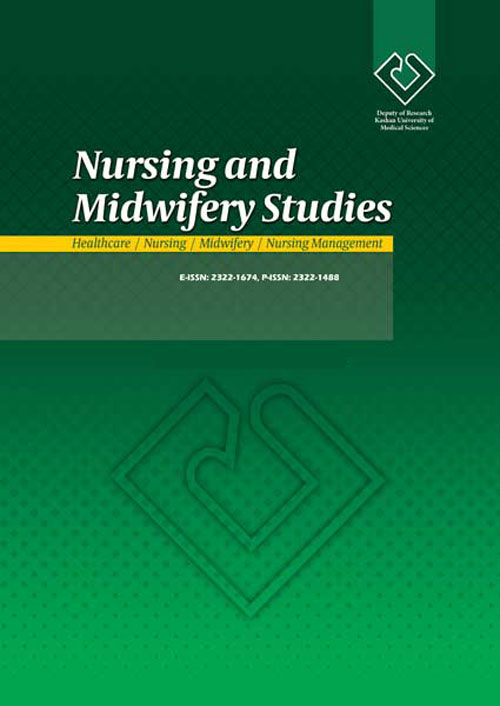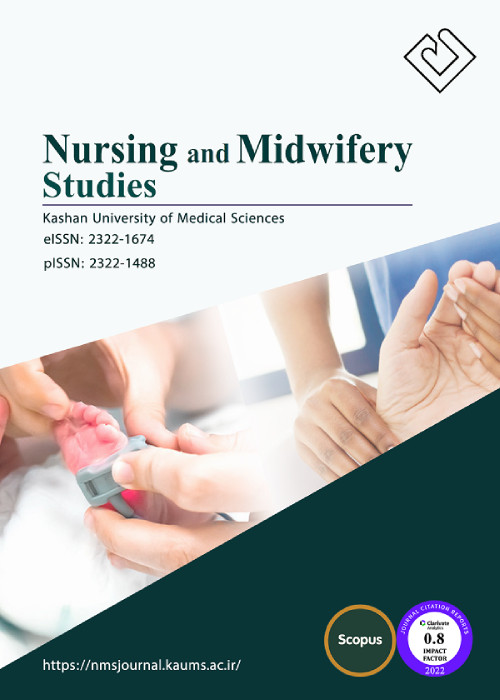فهرست مطالب

Nursing and Midwifery Studies
Volume:4 Issue: 1, Jan-Mar 2015
- تاریخ انتشار: 1394/01/28
- تعداد عناوین: 9
-
-
Page 1BackgroundIn Zahedan City in Southeast Iran, some women prefer to give birth at home despite the availability of the equipped hospitals and expert advice that hospital births are safer..ObjectivesThis study explains how Baloch women make decisions regarding the risks associated with childbirth at home versus a hospital. This study identifies and defines the factors that influence the choice of the place of delivery by Baloch women..Materials And MethodsThe article draws on data from a grounded theory. In particular, on in-depth interviews with 25 Baloch women, 21 of whom had planned home births and 4 planned hospital births in their most recent childbirth..ResultsSix categories emerged from the data as follows: 1) deliberation and risk assessment; 2) obstacles to hospital births; 3) preference for hospital births; 4) obstacles to homebirth; 5) preference for homebirth; and 6) risk management. The core category was deliberation and risk assessment. Our interviews showed that Baloch woman weighed the negative and positive aspects of each option when deciding on a childbirth setting. In this process, their assessment of risk included physical wellbeing and social-cultural values. Furthermore, their assessment of risk can, in some circumstances, result in delays or avoidance of having hospital childbirth..ConclusionsManagers and service providers need to know an ordinary woman’s perception of risk to address the gap between current and desired childbirth services and encourage women to use current hospital services..Keywords: Risk Assessment, Risk Management, Child, Decision Making, Iran
-
Page 3BackgroundPsychological violence is the most common form of workplace violence that can affect professional performance and job satisfaction of health care workers. Although several studies have been conducted in Iran, but there is no consensus regarding current status of such violence..ObjectivesThis study aimed to investigate the prevalence of psychological violence among healthcare workers employed at teaching hospitals in Iran..Patients andMethodsIn this cross-sectional study, 5874 health professionals were selected using multistage random sampling. Data were collected using a self-administered questionnaire developed by the International Labor Organization, International Council of Nurses, World Health Organization, and Public Services International. Descriptive statistics were used to analyze the data..ResultsIt was found that 74.7% of the participants were subjected to psychological violence during the past 12 months. Totally, 64.5% of psychological violence was committed by patients’ families, but 50.9% of participants had not reported the violence, and 69.9% of them believed that reporting was useless..ConclusionsThe results are indicative of high prevalence of psychological violence against healthcare workers. Considering non-reporting of violence in more than half of participants, use of an appropriate reporting system and providing training programs for health professionals in order to prevent and manage workplace violence are essential..Keywords: Workplace Violence, psychological Violence, Health Personnel, Health Care Setting, Iran
-
Page 4BackgroundCritical thinking is one of the most important concepts in the field of education. Despite studies published on nursing students’ critical thinking skills (CTS), some suggest that there is not enough evidence supporting the relationship between content of nursing education programs and nursing students’ CTS..ObjectivesGiven the existing discrepancies, this study aimed to compare the critical thinking skills of freshmen and senior nursing students..Patients andMethodsThis comparative study was conducted on 150 undergraduate freshmen and senior nursing students in Kashan University of Medical Sciences, during 2012. The students in the first and the last semesters of their study in nursing were entered in the study using the census method. Data were collected using a questionnaire including questions on demographic data and the California Critical Thinking Skills Test, form B. Data analysis was performed using the SPSS v.13 software. Descriptive statistics were calculated. Moreover, independent sample t-test and Spearman and Pearson’s correlation coefficients were used in the data analysis..ResultsBoth the freshmen and senior nursing students had low CTS. The mean critical thinking scores were 11.79 ± 4.80 and 11.21 ± 3.17 for the freshmen and the senior students, respectively (P = 0.511). Moreover, no significant correlation was found between the students’ score in CTS and their age, gender, high school grade point average (GPA), rank in university entrance examination (RUEE) and interest in the nursing profession..ConclusionsThe students were low skilled in critical thinking and their CTS did not significantly change during their nursing degree. Thus it may be concluded that the nursing education program did not affect the CTS of its students. Longitudinal studies are suggested for assessing nursing students’ critical thinking over time. Moreover, revising the curriculum and preparing nursing educators for implementing innovative and active teaching strategies are suggested.Keywords: Thinking, Mental Competency, Students, Nursing
-
Page 5BackgroundAbortion in Iran, like other Islamic countries is severely restricted except in a few exceptions. However, some women who have an unwanted or mistimed pregnancy are seeking abortion..ObjectivesThis study aimed to compare the contraceptive use and its related factors among repeat and first- time induced abortion seekers in Iran..Patients andMethodsIn this cross-sectional study, 417 married women (age range, 15-49 years) seeking abortion services at either a hospital or private office in Maku City, the northwest of Iran, were selected through convenience sampling between December 2010 and March 2011. All the subjects were asked about the contraceptive methods used during the three months before the current pregnancy and the use of any emergency contraception and forced sex. Women who mentioned reasons except than completing family size for their applying for abortion were excluded from the analysis. Characteristics of women were examined using chi-square and t test. T test and Mann-Whitney U test were used to compare contraceptive methods and the regularity of contraceptive use between repeat and first-time abortion seekers, respectively..ResultsAbout 33.8% of the repeat abortion-seekers and 76.8% of first-time abortion seekers were using male methods (withdrawal and condom). Utilization of an intrauterine device for birth control was higher among women seeking repeat abortion than in first-time abortion seekers (P = 0.003). All of 31 pill users in the repeat abortion-seeking group missed three or more pills per month for three times during the three months before contraception. The repeat abortion seekers had used condom more regularly than those in the first-time abortion seekers. Forced sex was more prevalent in the abortion seekers who had used male method..ConclusionsUsing male methods are prevalent in abortion-seeker women. An increased focus is needed on training the regular use of pills and using the emergency contraception for all of the couples who are first-time abortion-seekers. Moreover, information about the role of forced sex might be efficacious in decreasing illegally induced repeat abortion in couples who use condom or withdrawal methods..Keywords: Unwanted Pregnancy, Induced Abortion, Contraceptive Behaviors
-
Page 7BackgroundUrinary catheterization is one of the main measures used to treat and care for hospitalized patients. Several complications have been attributed to the presence of latex with routine Foley catheters. Therefore, some studies have recommended that Nelatone catheters be substituted for the ordinary Foley catheters to prevent these complications..ObjectivesThis study aimed to compare the rates of urinary tract infection (UTI) in rabbits catheterized either with Foley or with Nelatone catheters..Materials And MethodsA randomized controlled trial was conducted on 60 rabbits that were randomly assigned to three groups of twenty. The first group was catheterized using Nelatone catheter; the second group was catheterized using Foley catheter and the third group was studied without performing any catheterization. After seven days, urine samples were collected using suprapubic aspiration and were sent to the laboratory for culture. Descriptive statistics were calculated. Moreover, chi-square and Fisher’s exact tests were used for data analysis..ResultsAt the end of the study, four 4 cases in the Nelatone group and 12 cases in the Foley group presented with UTI (P = 0.01). No positive urine cultures were found in the control group..ConclusionsThe Nelatone catheters, compared with the Foley ones, had a lower risk of UTI in the long term use. Verifying this claim by further studies can have an important role in reducing UTIs in patients using urinary catheters..Keywords: Urinary Tract Infection, Urinary Catheterization, Catheters, Rabbit
-
Page 8
-
Page 9BackgroundThe effect of exercise during hemodialysis has been a controversial issue, however, there are just few studies about the effect of active exercise during hemodialysis..ObjectivesThis study aimed to compare the effects of passive and active intradialytic pedaling exercises on dialysis efficacy, electrolytes, hemoglobin, hematocrit, blood pressure and health-related quality of life in hemodialysis patients..Patients andMethodsThis quasi-experimental study was conducted on 16 hemodialysis patients in Akhavan hemodialysis center in Kashan from April to November 2013. Active or passive intradialytic pedaling exercise was performed using a Mini-Bike for 30 minutes during the first two hours of the dialysis sessions. The quality of life (QOL) was assessed before and after the intervention. Blood pressure was examined at the beginning and then hourly during the dialysis sessions. Dialysis efficacy, levels of phosphorus, calcium, sodium, potassium and Blood urea nitrogen (BUN) were measured at the end of the intervention. Kolmogorov-Smirnov test, paired t test, Wilcoxon signed rank and Friedman tests and repeated measure analysis of variancewere used to analyze the data..ResultsNo significant changes were observed in serum potassium, phosphorus and calcium levels at the end of the passive exercise program compared to the baseline. However, phosphorus levels were significantly decreased in the active exercise program (P < 0.05). Moreover, the mean diastolic blood pressure was significantly decreased after the passive exercise (P = 0.039). Passive exercise did not significantly change the dialysis efficacy, urea reduction rate, hemoglobin and calcium levels. The mean overall QOL was 63.78 ± 21.15 at the beginning of the study, which was increased to 77.07 ± 21.14 at the end of eight weeks of the intradialytic exercise (P = 0.007).ConclusionsThe passive intradialytic exercise had a positive effect on blood pressure. The active exercise could decrease the serum phosphorus and potassium levels. Moreover, both exercise programs could significantly improve the QOL. Both active and passive intradialytic exercises can have some beneficial effects..Keywords: Exercise, Hemodialysis, Quality of Life


